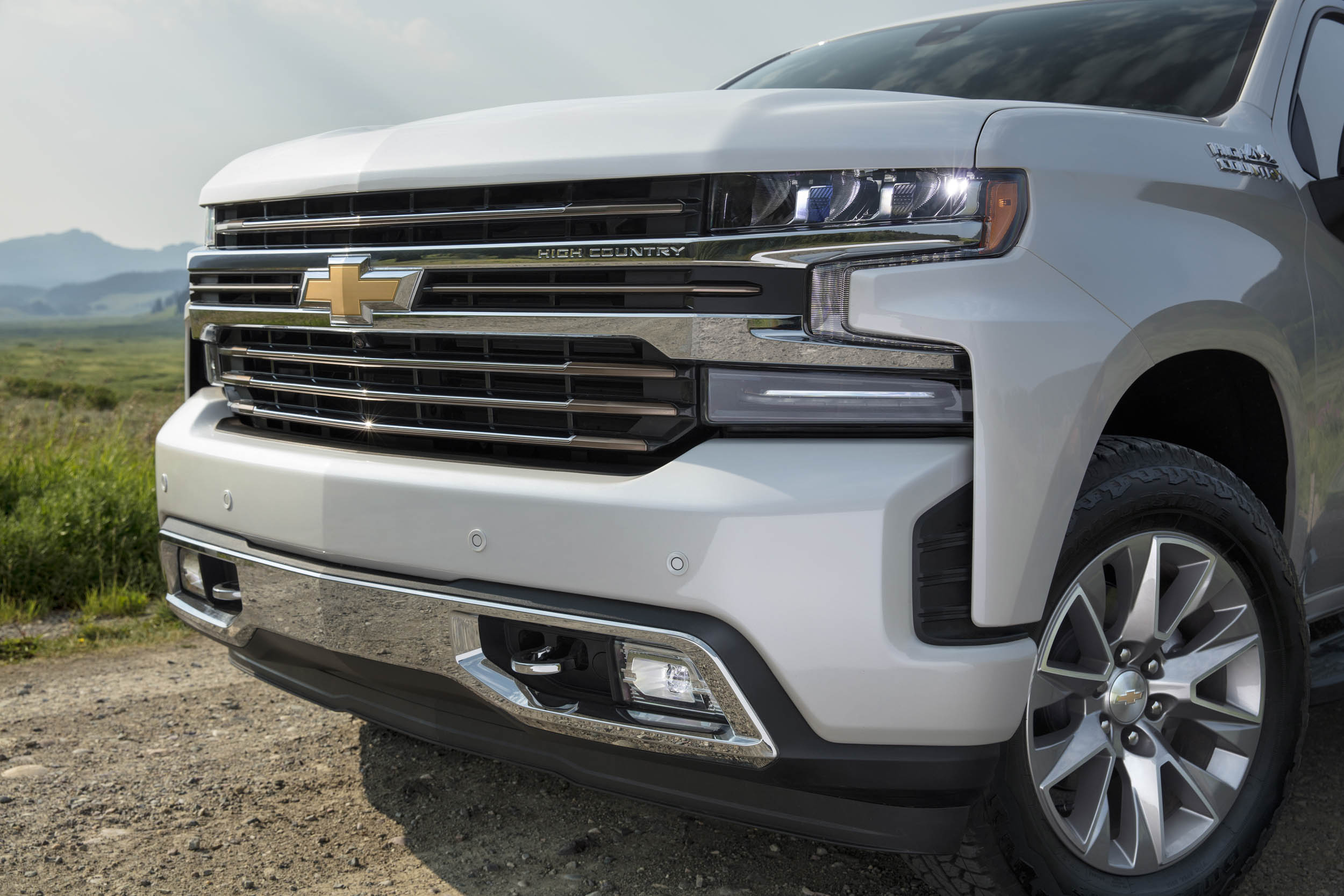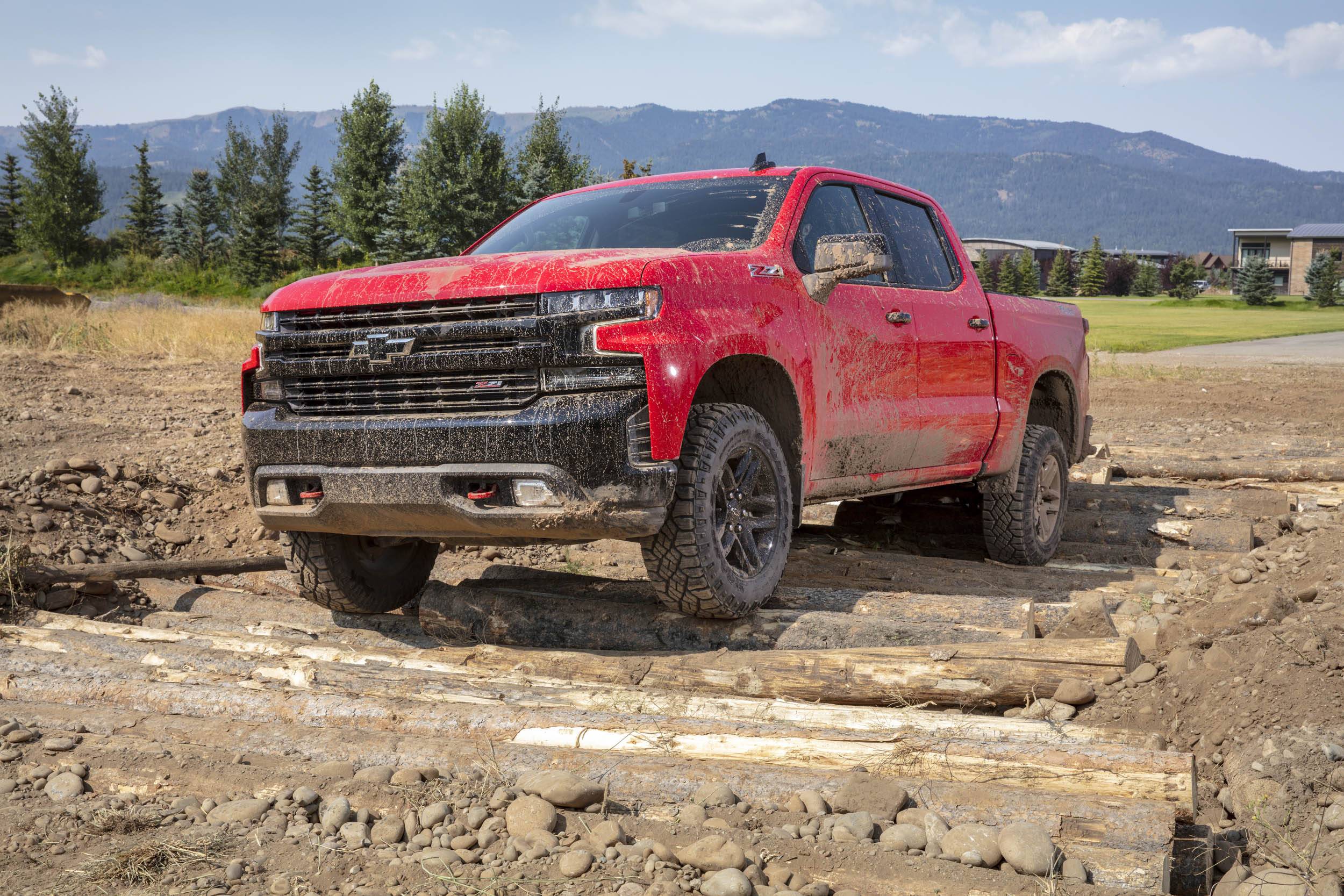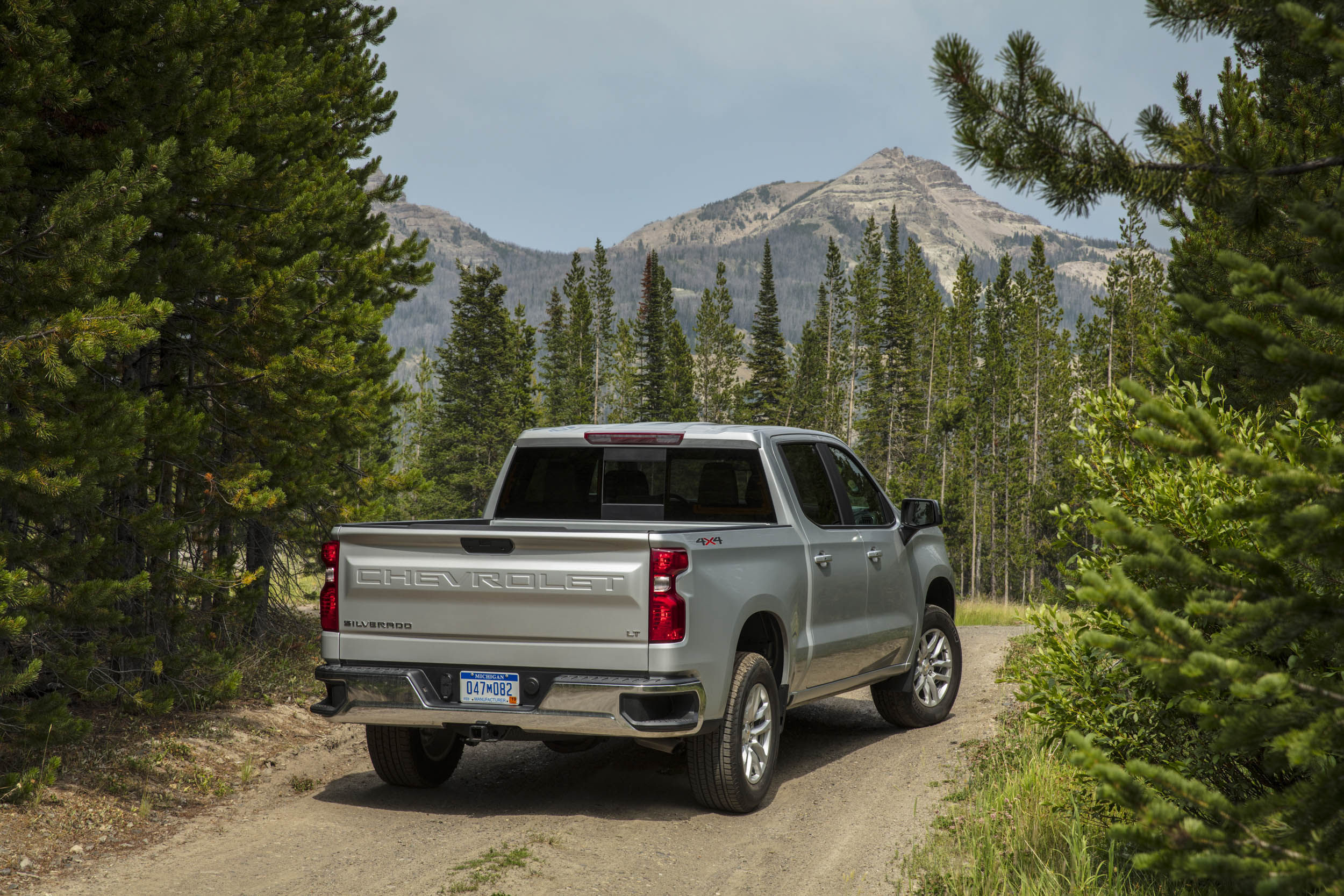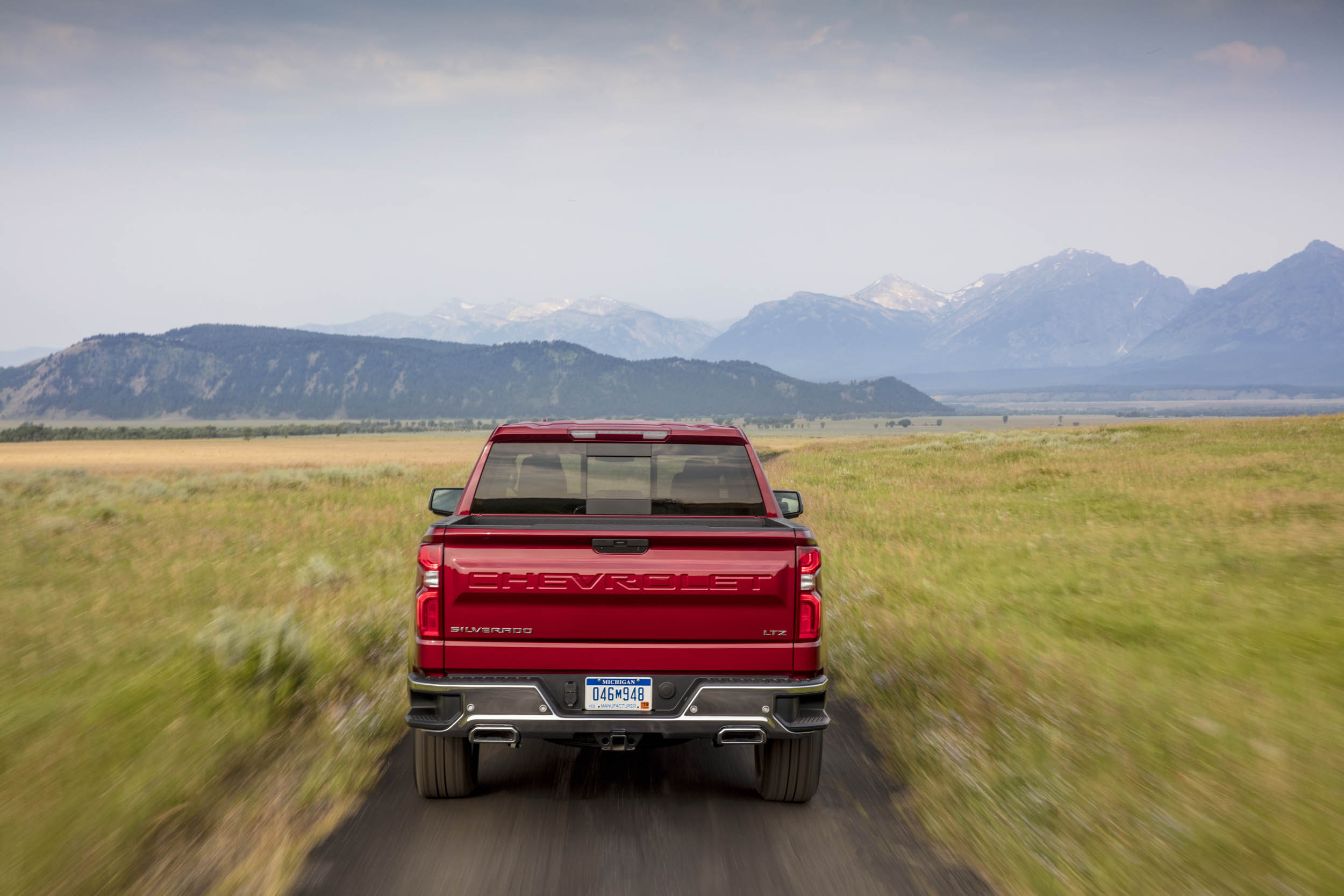Media | Articles
The 2019 Chevrolet Silverado makes driver and truck feel like one
We’re in a 2019 Chevy Silverado RST Crew Cab with a 5.3-liter V-8 and eight-speed automatic, and the all-new body structure is immediately apparent. There is a oneness between the cab and the bed, and the truck feels solid. Planted to the pavement. The steering effort is just right, and the ride is smooth without being floaty. The interplay between the V-8 and the transmission is exceptional. Hit the gas and the truck surges forward, building speed fluidly, with butter-soft upshifts. Now in its second century of making trucks, Chevy has shown with the new Silverado just how far it has come from its days making simple, humble work vehicles.
The connectedness between driver and truck is created partly by the responsiveness of the drivetrain. You also sit closer to the front of the vehicle than before, thanks to a shallower instrument panel and a shorter distance between the front wheels and the front bumper.
Later, we drive a Silverado High Country Crew Cab with the 6.2-liter V-8, a $2495 upgrade, and its 10-speed automatic. The big engine dishes out its 420 horsepower and 460 lb-ft of torque—figures unchanged from the last-generation Silverado—in a relaxed but reassuring way, the transmission delivering the V-8’s gobs of go to the axles with calm, one gear handing off to the other as smoothly as sprinters and a baton.


The muffled mechanical sounds seeping into the cabin are as much those of a sport sedan as a pickup truck, and indeed this fully loaded, $65,655 High Country is essentially a high-riding, all-wheel-drive luxury sedan, just one that also happens to have the utility, durability, capability, and desirability of a pickup truck.
Marketplace
Buy and sell classics with confidence
Chevy sold its first truck, a far more primitive creation, 100 years ago this past January. To celebrate the centennial, it introduced its new Silverado at the Detroit auto show, presenting the biggest changes to the Chevy (and its GMC Sierra cousin) in two decades. Stung by criticism that its last truck re-do, for the 2014 model year, was staid and too derivative of the 2007–13 models, GM encouraged its designers to think big and boldly for the 2019 Silverado.
Growing evermore
The overall proportions have changed considerably, as the new body structure allowed designers to give the Silverado a shorter hood and a shorter front overhang even while stretching its wheelbase by four inches. Overall length is up about an inch and a half, the driver sits more than an inch higher, and the hood and roofline are both about an inch taller than on 2018 models. Interior volume also increases, with the highest-volume model, the Crew Cab, getting three additional inches of rear-seat legroom.

Cargo volume also increases, with a 63-cubic-foot cargo box for short-bed models, versus 53 cubic feet in the outgoing model. The standard bed rises from 62 to 72 cubic feet; the long bed, from 75 to 89 cubic feet. These improvements were made possible by stamping the wheel well and inner bed body panels separately, rather than as one, thereby shrinking the amount of space between the inner and outer sidewalls while increasing the maximum width of the bed by nearly seven inches.
Leaner and meaner
Even with those increases, the 2019 Silverado weighs an average of 450 pounds less than comparable 2018 models. That’s due to thinner but higher-strength steel in the bed, which itself shaved some 80 pounds; more aluminum in the suspension, which saves another 88 pounds; and aluminum for the tailgate, doors, and hood. “We think we have a more effective way of mixing materials [steel and aluminum] than Ford,” says Chevy marketer Hugh Milne. “We used aluminum on the easy-to-replace body components.”
If the last Silverado’s conservative lines can be attributed to the somber atmosphere at GM at the beginning of this decade, when the company was in the throes of a government-led bankruptcy and reorganization, the 2019 model’s atomic-robot face speaks to a newfound exuberance and a play for younger buyers.


“When my 10-year-old son first saw the Silverado,” recalls Gary Ruiz, a member of the exterior design team, “he said, ‘Dad, that truck looks like it’s for the zombie apocalypse.’ That’s when I knew we had succeeded.” Ruiz also says that the line workers at GM’s plant in Fort Wayne, Indiana, who are usually nonplussed by a model changeover, were astounded by the differences between the new and old trucks when the 2019 Silverados started coming down the line, mixed in with the last examples of the old model.
The lineup
There’s no describing the Silverado’s styling in one blanket statement, because the lineup has expanded from five to eight models, and they differ greatly. At the lower end of the scale, we have what Chevy marketers call the “High Value” trio: The Work Truck, starting at $29,795; the Custom, at $36,095; and the Custom Trail Boss ($40,095, new for 2019; more details below). All three have C H E V R O L E T stenciled into their grille crossbar, with a demure bow-tie badge below. Although a modern look, it’s a nod to the schnozzes of C/K pickups from the 1960s and ’70s.
The upper five trims, which place different versions of the traditional bow-tie badge front-and-center, are divided into two more tiers. The “High Volume” trio starts with the $38,395 LT, which has chrome bumpers and door handles; then moves to the new-for-2019 RST, with body-colored bumpers and door handles, at $40,295. Chevy expects these two trims alone to comprise 50–60 percent of Silverado sales. The LT Trail Boss, also new for 2019, starts at $47,395.
20180813141548)



Offered on both Custom and LT trims, the Trail Boss gets you a two-inch suspension lift (better to let the factory do it than the aftermarket, Chevy engineers point out, although your Chevy dealer can also install it on other Silverado models; either way, it’s under warranty) and the Z71 off-road package, which itself has become a GM truck sub-brand and here includes a locking rear differential, skid plates, Rancho shocks (which sound like they should be served with eggs and hot sauce), 18-inch wheels, and Goodyear Duratrac off-road tires.
Trucking on the trail
For the media drive program in Wyoming, Chevy set up an off-road course with logs, boulders, mud, and whoop-de-whoop gulleys where we enjoyed thrashing an LT Trail Boss. On the subject of off-roading, Chevy insists that it has no plans to build an extreme off-road Silverado to compete with the Ford F-150 Raptor. “For us to spend time, money, and energy developing a low-volume Raptor-fighter?” asks marketing man Milne rhetorically. “We will see how the market reacts to the Trail Boss first.”
At the top of the heap we find two “High Feature” Silverados: the chrome-laden, $44,495 LTZ (which can also be outfitted as a Z71), and the luxurious High Country, which starts at $54,495. A new power-up/down tailgate that’s controlled by the key fob or interior and exterior buttons is optional on LTZ and standard on High Country.

Exterior lighting treatments vary by model, with a mixture of incandescent and LED bulbs, heavy on the latter the farther up the Silverado food chain you go. Designer Ruiz refers to the boomerang-shaped daytime running lamps (DRLs) as “light curtains” in the LTZ and High Country and as “light pipes” in the mid-level models. Whatever you want to call the Silverado’s exterior lights, we imagine it won’t be long before truck aficionados can distinguish the eight models from each other on nighttime roads. At the rear, the 2019 Silverados get C H E V R O L E T stamped into the tailgate, another reference to past glory.
Four-cylinder joins the family
On the powertrain front, Chevy’s first four-cylinder pickup engine, a brand-new 2.7-liter turbocharged inline four paired with an eight-speed automatic, produces 310 hp and 348 lb-ft of torque. It isn’t yet available for test drives but engineers stress that it was developed from the ground up to be a truck engine, meaning it’s not a car engine that was beefed up for truck use. The 2.7-liter’s fuel economy numbers haven’t been released, but figure on a reasonable improvement over the 5.3-liter/6.2-liter V-8 figures of 23/20 mpg highway, respectively.
For lower trims, the carryover 4.3-liter V-6 with a six-speed gearbox and the 5.3-liter V-8 mated to an eight-speed still feature GM’s Active Fuel Management, which shuts down half the cylinders at a time. But new versions of the 5.3-liter V-8 and the 6.2-liter V-8 have a more advanced system, Dynamic Fuel Management. DFM’s 17 different cylinder-firing patterns react more efficiently to the driver’s torque demand, as perceived by accelerator pressure. These efforts are said to improve city fuel economy by about 1 mpg.


With the Max Towing Package and the 5.3-liter V-8, the Silverado’s tow rating is up 400 pounds from 2018, at 11,600 pounds. The 6.2-liter V-8, which is now exclusively mated with four-wheel drive, has a maximum tow rating of 12,200 pounds, up 500 pounds. A 5.3-liter Silverado made easy work of towing a 6000-pound enclosed trailer through the Snake River Canyon near Alpine, Wyoming, at an elevation of about 6000–7000 feet. The Max Towing Package’s quartet of cameras—one on each side view mirror, one on the tailgate, and one mounted on the back of your trailer—make it easy to back up to and hitch your load and then keep your eyes on your entire rig through the in-cabin screen. It’s all part of a trailering app that’s optional on the LTZ and standard on High Country.
Now that we’ve had our first chance behind the wheel, we can say that the Silverado is definitely worthy of carrying Chevy into its second century of truck-making. Production of the new models just started, and they’re trickling into dealerships. There’s more to come, including not only the 2.7-liter four-cylinder engine but also a new Duramax 3.0-liter inline six-cylinder turbodiesel engine mated to the 10-speed automatic, in early 2019.

20180813141242)



















